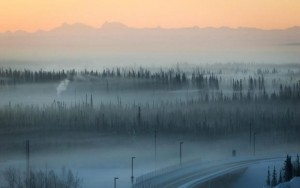The Alaska Department of Environmental Conservation is requesting that the U.S. Environmental Protection Agency no longer consider Fairbanks and North Pole together when it comes to air quality regulation. If approved, the change could free Fairbanks from more stringent emissions regulations.

Fairbanks and North Pole are currently regulated as a single entity by the Environmental Protection Agency. An EPA designated fine particulate pollution non-attainment area for wintertime emissions, primarily wood and coal smoke covers Fairbanks to the west, and North Pole to the east, but the communities air quality is no longer on par.
“On the western side the air quality appears to be improving,” says Alaska Department of Environmental Conservation program manager Cindy Heil.
Heil says Fairbanks and North Pole have diverged relative to a federal 35 microgram per cubic meter pollution standard.
Several factors play into the growing disparity, including the concentrations of wood and coal burners, and localized atmospheric conditions that trap smoke in neighborhoods. Heil says DEC’s requested division of the non-attainment area would keep Fairbanks from being covered under an impending EPA “serious” air quality designation.
North Pole Mayor Bryce Ward opposes the dividing the area, fearing it will make it more difficult for his small city to reduce pollution.
Ward says that could include inability to leverage grants and other resources to combat pollution. The EPA is expected to take over a year to rule on the request. Meanwhile, Ward is looking toward the state supported Interior Energy Project to help solve the air quality issue.
The state is currently reviewing five finalist company proposals for getting clean-burning natural gas to Fairbanks, North Pole area. Selection of a project partner is expected in December.
Dan Bross is a reporter at KUAC in Fairbanks.




